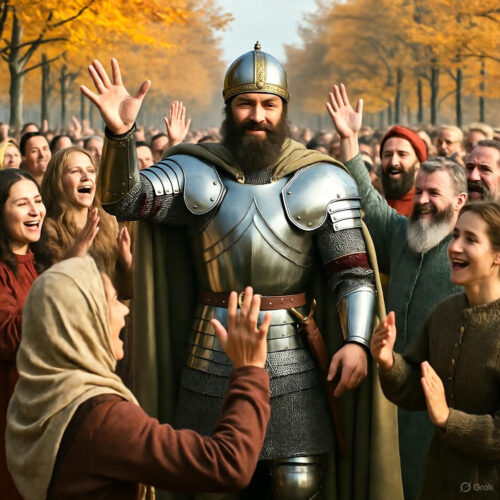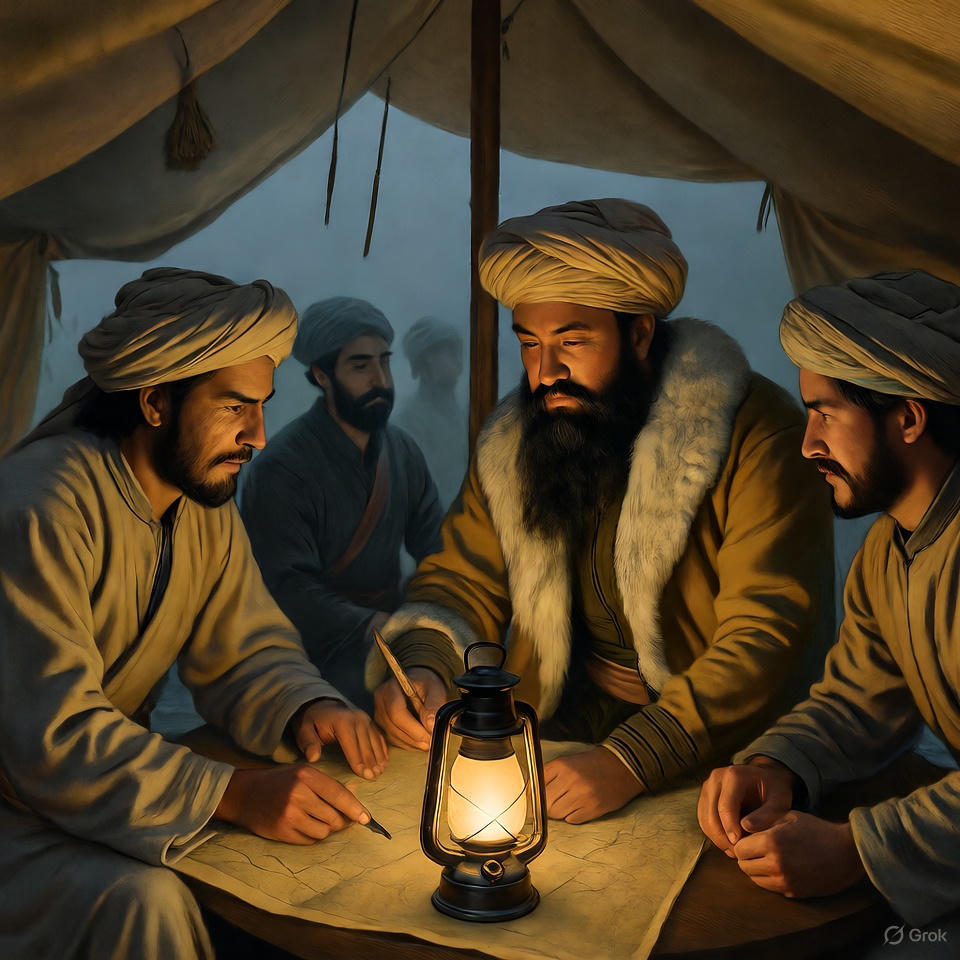On October 8, 1480, along the banks of the Ugra River in what is now Russia’s Kaluga Oblast, two mighty armies faced each other in a tense, bloodless standoff that would ripple through centuries of history. This event, known as the Great Stand on the Ugra River, pitted the forces of the Grand Duchy of Moscow against the remnants of the once-dominant Great Horde. It wasn’t a clash of swords and arrows in the traditional sense but a psychological and strategic duel where the river itself became a silent ally, halting an invasion and symbolically shattering the chains of Mongol overlordship. Imagine the autumn chill settling over the landscape, the Ugra’s waters murmuring as if aware of their role in destiny. This was no ordinary confrontation; it marked the twilight of an era of subjugation and the dawn of Russian sovereignty. Dive into the intricacies of this pivotal moment, where strategy triumphed over brute force, and discover how its lessons of endurance and foresight can ignite personal triumphs today.
The roots of this standoff trace back to the turbulent 15th century, a time when the vast Eurasian steppes were a chessboard of shifting alliances and crumbling empires. The Mongol Golden Horde, which had swept across Eastern Europe in the 13th century under Genghis Khan and his successors, had long exacted tribute from Russian principalities. By the late 1400s, however, the Horde had splintered into fractious khanates: the Great Horde in the lower Volga region, the Crimean Khanate to the south, and others vying for scraps of power. The Grand Duchy of Moscow, under the ambitious Ivan III—often called Ivan the Great—emerged as a unifying force among Russian lands. Ivan’s predecessors had paid annual tribute to the Horde, a humiliating “Tatar yoke” that symbolized vassalage. But Ivan, married to the Byzantine princess Sophia Palaiologina, dreamed of a centralized Russian state, drawing inspiration from the fallen Eastern Roman Empire. He began consolidating power, annexing principalities like Novgorod in 1478 and ceasing tribute payments to the Horde as early as 1476.
The immediate prelude to the stand-off brewed in the spring of 1480. Akhmat Khan, ruler of the Great Horde and a descendant of Genghis Khan through the line of Jochi, sought to reassert dominance. Akhmat commanded what chronicles describe as the largest Tatar army of the century, perhaps 50,000 to 100,000 warriors, including nomadic horsemen skilled in archery and hit-and-run tactics. His forces gathered near the upper Don River, aiming to march northwest toward Moscow. Diplomatic intrigue complicated matters: Akhmat had allied with Casimir IV Jagiellon, King of Poland-Lithuania, who promised reinforcements to pinch Moscow in a pincer movement. In response, Ivan III forged his own alliances, notably with the rival Crimean Khanate under Mengli Giray, who harassed Lithuanian borders to divert Casimir’s troops.
Internal Russian strife nearly derailed the defense. Ivan quarreled bitterly with his brothers, Andrey Bolshoy of Uglich and Boris of Volotsk, over inheritance and influence. These brothers even plotted with Casimir, threatening civil war. News of Akhmat’s advance reached Moscow in May 1480 via scouts and refugees. Panic gripped the court; some boyars (nobles) urged Ivan to flee north to safer territories like Beloozero, echoing past evasions. But Ivan, bolstered by church leaders and Sophia’s counsel, refused. He mobilized rapidly: In June, he dispatched his son, Ivan the Young (co-ruler and heir), to fortify Serpukhov on the Oka River; his brother Andrey the Less to Tarusa; and positioned himself at Kolomna. The Oka River served as Moscow’s primary southern bulwark, a natural barrier fortified with wooden stockades and watchtowers.
As summer waned, Tatar scouting parties probed south of the Oka, clashing with Russian outposts. Akhmat’s army veered northwest, bypassing direct assaults on the Oka to exploit the terrain. Russian forces shifted westward to the Ugra River, a tributary that formed a strategic extension of defenses after the Oka’s bend at Kaluga. Troops from Tver, recently subdued by Moscow, reinforced the line. By late September, Ivan returned to Moscow for urgent councils with bishops, boyars, and even Orthodox clergy who framed the conflict as a holy struggle against infidels. The rift with his brothers was mended through diplomacy and threats, securing their contingents. Precautions escalated: The state treasury, icons, and the royal family—including Ivan’s grandchildren—were evacuated north. Border towns were depopulated to deny the invaders supplies, a scorched-earth precursor.
Akhmat’s host arrived at Vorotynsk, just south of the Ugra-Oka confluence, in early October. He camped on the Oka’s west bank, awaiting Casimir’s Lithuanians, who were bogged down by Crimean raids in Podolia and peasant revolts. To disrupt Akhmat’s rear, Ivan sent a diversionary force under Vasily Nozdrevaty and the exiled Nogai prince Nur Devlet eastward along the Oka and Volga, though their raids yielded limited results. On October 3, Ivan established command at Kremenets (near modern Medyn), overseeing a defensive front stretching about 60 versts (roughly 64 kilometers). Russian numbers are estimated at 20,000 to 40,000, including infantry with early firearms, archers, and cavalry—outmatched in mobility but advantaged by terrain and artillery.
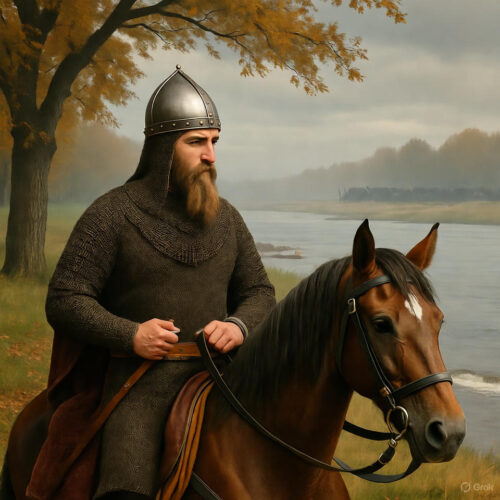
The climax ignited on October 8, 1480, around one o’clock in the afternoon. Akhmat, impatient with delays, ordered his troops to ford the Ugra at multiple points along a five-kilometer stretch from its mouth westward. Tatar horsemen, clad in lamellar armor and wielding composite bows, charged into the shallows, but Russian defenders—positioned on higher banks with barricades—unleashed volleys of arrows and cannon fire. The Ugra’s width, swollen by autumn rains, blunted Tatar archery, as arrows lost velocity mid-river. Chronicles recount fierce skirmishes lasting nearly four days, with Tatars attempting ladders and rafts but repelled each time. Casualties were light compared to full battles, but the psychological toll mounted. Akhmat withdrew two versts south to the Luza River, then tried a nocturnal flanking maneuver toward Opakhov, only for Russian scouts to detect and block it with reinforcements.
Ivan, ever the tactician, initiated parleys through envoys, stalling while bolstering lines. For the ensuing weeks, the armies glared across the water in a bizarre impasse—soldiers taunting, minor probes exchanged, but no major engagement. Autumn deepened; frost nipped at heels, and fodder for the Tatars’ vast herds dwindled. Akhmat’s camp suffered from disease and desertions, while he clung to hopes of Lithuanian aid that never materialized. Ivan, facing similar strains, executed a masterful feint on October 26: He pulled forces northeast to Kremenets, then east to Borovsk, concentrating defenses to shield Moscow and bait an overconfident pursuit. Akhmat, wary of ambush or winter’s bite freezing the river (eroding its barrier role), demurred. On November 8, he decamped southward, raiding Lithuanian fringes like Mtsensk for spoils. His son Murtaza probed south of the Oka briefly but was routed. Ivan learned of the retreat on November 11 and returned triumphantly to Moscow on November 28, greeted as a liberator.
The outcome was a de facto Russian victory without pitched battle—a rarity in medieval warfare. Akhmat’s failure to breach defenses preserved Moscow intact, affirming Ivan’s sovereignty. Yet, the khan’s fate was sealed elsewhere: In January 1481, he fell in a skirmish with Nogai forces led by Ibak Khan near the Donets River, betrayed by internal rivals. By 1502, the Crimean Khanate obliterated the Great Horde, reshaping steppe politics and igniting prolonged Russo-Crimean conflicts until Catherine the Great’s conquests in the 18th century.
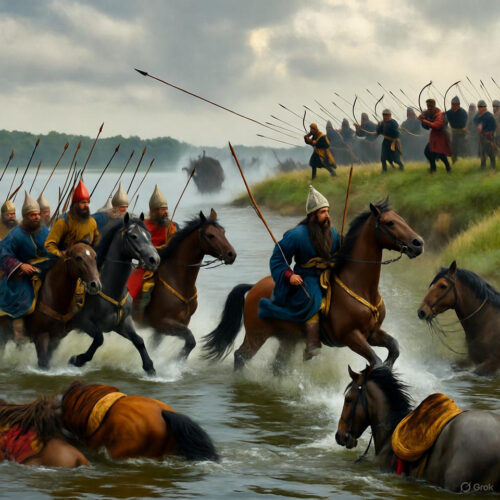
Significance extends beyond the immediate: In Russian lore, this “stand” symbolizes the end of the Tatar yoke, a narrative cemented in 16th-century chronicles like the Illustrated Chronicle Compilation, featuring vivid miniatures of armies arrayed across the river. Ivan III’s reign, spanning 1462–1505, saw Moscow’s territory double, the Veche (popular assembly) abolished in annexed lands, and the double-headed eagle adopted as a Byzantine heir. The event underscored evolving warfare: Firearms and fortifications neutralized nomadic advantages, foreshadowing gunpowder’s dominance. Historians debate its decisiveness—tribute had lapsed years prior, and Tatar incursions persisted (e.g., Crimean raids in 1521 nearly sacked Moscow)—but it psychologically liberated Russia, enabling Ivan’s grandson Ivan IV (the Terrible) to expand aggressively.
Myths swirl around the stand-off. Early accounts embellish Ivan’s piety; legend claims he vowed to build churches if victorious, leading to monasteries like that at Borovsk. Chronicler Nikolay Karamzin quipped the armies “ran away from each other,” highlighting the mutual retreat’s absurdity. Some tales attribute success to divine intervention or a “miracle of the river,” but pragmatic factors—weather, logistics, alliances—dominate scholarly views. Tatar sources are scarce, as oral traditions faded with the Horde’s collapse, but Russian narratives portray Akhmat as overconfident, blinded by steppe hubris.
Delving deeper into the era’s context reveals a world in flux. The Renaissance stirred in Europe, while the Ottoman Empire rose post-Constantinople’s fall in 1453—Sophia Palaiologina’s uncle was the last Byzantine emperor. In Russia, Orthodox Christianity unified disparate Slavs against “pagan” nomads, with monasteries serving as ideological fortresses. Economically, Moscow controlled fur trade routes, funding armies; the Horde relied on tribute and raids, vulnerable to fragmentation. Akhmat’s army comprised diverse ethnicities—Turco-Mongols, Kipchaks, Circassians—bound by khan’s authority, which wavered amid succession disputes.
Ivan’s personal life intertwined with strategy: At 40, he navigated court intrigues, including blinding his son Ivan the Young later (unrelated to 1480). His marriage to Sophia imported Byzantine customs, like centralized autocracy. The stand-off’s bloodlessness contrasted brutal contemporaries, like the Wars of the Roses in England. Post-event, Ivan subdued his brothers’ rebellions in 1481, solidifying rule.
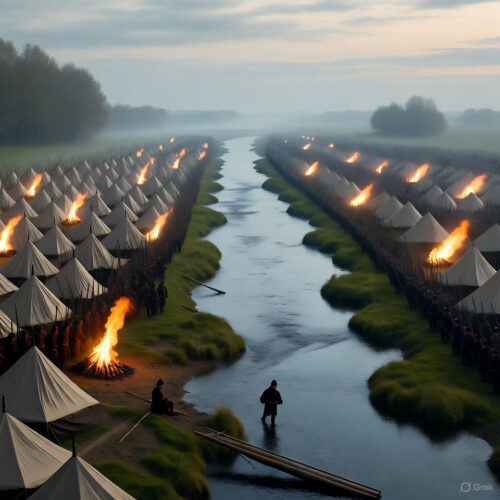
The diversionary raids merit elaboration: Vasily Nozdrevaty’s force, though small, sowed chaos along the Volga, potentially deterring Horde reinforcements. Crimean allies under Mengli Giray struck Lithuania effectively, tying down Casimir—his death in 1492 would shift balances further. Terrain played hero: The Ugra’s meanders and marshes funneled attackers into kill zones, while Russian pioneers built abatis (felled trees) overnight.
In the broader Mongol legacy, the Golden Horde’s peak under Özbeg Khan (1313–1341) saw Islam’s adoption, influencing Russian culture via loanwords and architecture. But by 1480, plagues, Timur’s invasions (1390s), and internal feuds eroded it. The stand-off accelerated this, paving for Muscovy’s “gathering of Russian lands,” culminating in the Tsardom under Ivan IV.
Modern historiography nuances the “yoke” myth: Some scholars, like Tatar historians, view it as exaggerated Russian propaganda, noting continued trade and alliances. Yet, the event’s emblematic power endures—in 2010, a monument rose at the site, inscribed with its legacy. Russian President Dmitry Medvedev once cited it as national pride.
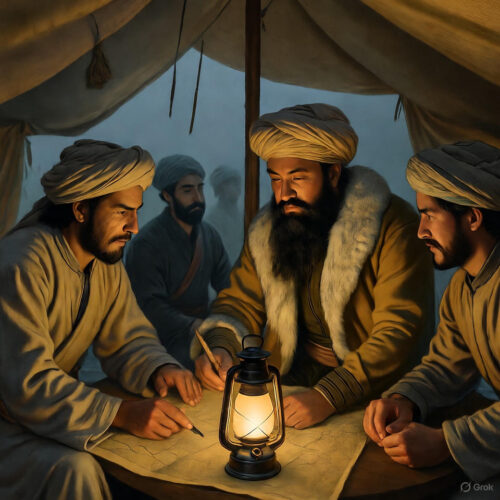
Transitioning from history’s grand stage to personal empowerment, the Great Stand teaches that victory often lies in steadfast resolve rather than reckless charge. Akhmat’s aggression faltered against Ivan’s calculated defense, mirroring life’s battles where patience outlasts impulsivity. The river’s barrier parallels personal boundaries—unyielding yet navigable with wisdom.
Applying this to individual life yields tangible benefits:
– **Embrace strategic patience in conflicts**: Like Ivan awaiting reinforcements, pause before reacting in disputes—whether workplace rivalries or family tensions. This prevents escalation, allowing clearer paths to resolution, fostering long-term alliances over short-term wins.
– **Unite divided fronts**: Ivan reconciled with brothers amid crisis; today, mend personal rifts by initiating honest dialogues, strengthening your support network for career advancements or emotional resilience.
– **Leverage natural barriers wisely**: The Ugra shielded Moscow; identify and fortify your “rivers”—habits like daily reflection or skill-building—that deter life’s “invasions” such as stress or setbacks, turning vulnerabilities into strengths.
– **Feint and reposition boldly**: Ivan’s withdrawal to Borovsk lured no pursuit; in pursuits like job hunts or goals, test maneuvers—pivot careers or habits without fear, as controlled retreats often lead to advantageous positions.
– **Anticipate seasonal shifts**: Winter loomed, forcing Akhmat’s retreat; monitor life’s cycles—economic downturns or personal burnout—and prepare contingencies, like saving or skill diversification, to emerge unscathed.
A practical plan to integrate these:
- **Assess the landscape**: Weekly, journal threats (e.g., toxic relationships) and assets (skills, allies), mapping defenses like Ivan’s Oka line.
- **Mobilize quietly**: Build reserves—financial, emotional—through consistent habits, such as 30 minutes daily learning, echoing preparations in 1480.
- **Engage selectively**: In standoffs, negotiate first; practice active listening in conversations to de-escalate, turning potential foes into neutrals.
- **Execute the stand**: When pressured, hold ground with boundaries—say no assertively—while scouting flanks via networking or advice-seeking.
- **Claim the victory**: Post-resolution, reflect and advance; celebrate small wins to build momentum, transforming historical endurance into personal sovereignty.
This ancient river’s whisper endures, motivating us to stand firm, for in patience lies true liberation.
